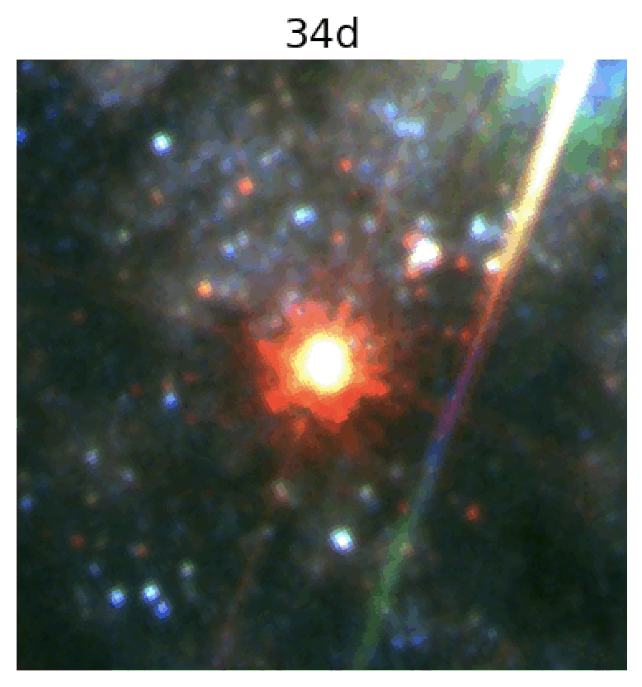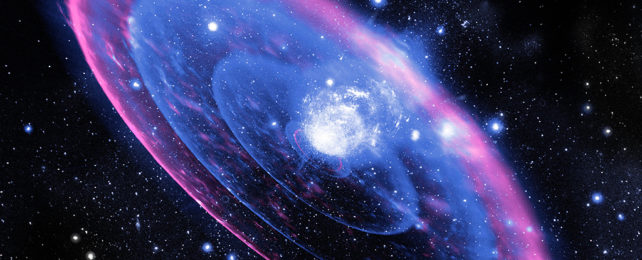The last screams of light emitted by a dying star have been preserved in a series of eerily beautiful images, slowly echoing across the cosmos.
The Hubble Space Telescope has captured in spectacular detail the flash of light that followed a massive star going supernova in 2016, as the glow spread outward over a period of more than five years.
The resulting animation of stitched-together images is a treasure trove of information about the evolution of dying stars, and the dust surrounding the supernova in its home galaxy of Centaurus A.
"A good everyday analogy is to imagine the finale of a fireworks show – the bright burst of light from a shell at the end of the show will light up the smoke from earlier shells that is still lingering in the area," says astronomer Stephen Lawrence of Hofstra University in the US.

"By comparing a series of photographs taken over several minutes, you could measure all sorts of information that is not directly related to the most recent explosion that is lighting up the scene, things like how many shells had previously exploded, how opaque is the smoke from a given shell, or how fast and in what direction was the wind blowing."
Light echoes are a truly stunning phenomenon that can only really be seen from a distance. They occur when something produces a flash of light that radiates out into space. If that light encounters a physical barrier, such as clouds of cosmic dust, it will reflect, arriving at a different time from the initial burst. It's pretty much the same thing as a sound echo, but with light. We can use these light echoes to help map and understand space, and the objects within it.
When a supernova was observed in 2016, astronomers took note, and repeatedly returned to the host galaxy, Centaurus A, located more than 12 million light-years away, to see if they could observe changes over time. That perseverance paid off. Not only were they able to collect data on the fading light of the supernova, named SN 2016adj, they managed to capture its light echoes.
"The blast wave from this powerful supernova explosion is racing outwards at over 10,000 kilometers (more than 6,200 miles) per second," says astronomer Lluis Galbany of the Institute of Space Sciences in Spain.
"Ahead of this blastwave is an intense flash of light emitted by the supernova, and this is what is causing the expanding rings we can see in the images. Supernovae are of interest as these cosmic explosions produce many of the heavy elements such as carbon, oxygen and iron, which make up our galaxy, stars and our planet."
Centaurus A is a bit of an oddball. It's classified as an elliptical galaxy, which are usually smooth, oval-shaped galaxies with very little dust and very old stars. However, Centaurus A is very dusty, bursting with star formation, and kind of warped. These are all the signatures of a cosmically recent collision with another galaxy, the effects of which are yet to settle down.
It's thought when the light from the supernova traveled towards Earth, it would have encountered multiple clouds of dust. From our position, we'd see this as a sequence of rings expanding in size. Four distinct light echoes were observed in the five-year observation period, which meant four dust clouds, each large enough and dense enough to produce a light echo.
These light echoes allowed the researchers, led by astronomer Maximilian Stritzinger of Aarhus University in Denmark, to map the dust next to the supernova. Their analysis suggests that the dusty structures contain spaces filled with a material that is too low in density to produce a detectable light echo.
Although we're pretty excited to get our eyeballs on an image of Centaurus A from JWST, which will cut through the dust to see the enigmatic heart of the galaxy, the research shows that there are some observations for which Hubble is still king. Since Hubble has been in space for decades, it has been able to capture a multi-year observation that provides detailed information about the structure of another galaxy.
"The data set is remarkable and enabled us to produce very impressive colored images and animations that exhibit the evolution of the light echoes over a five-year period," Stritzinger says. "It is a rarely seen phenomenon previously only documented in a handful of other supernovae."
The research has been published in The Astrophysical Journal Letters.
